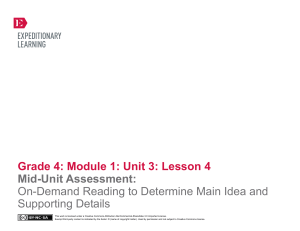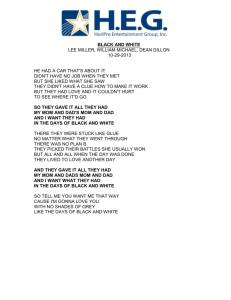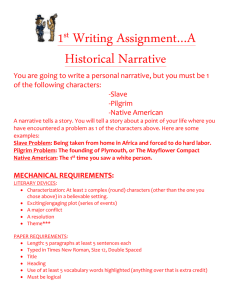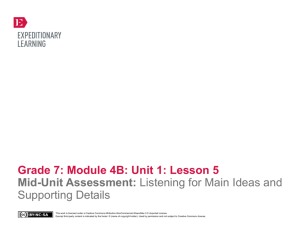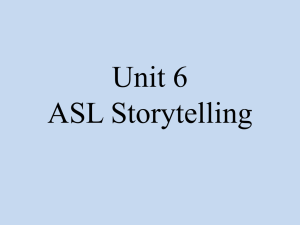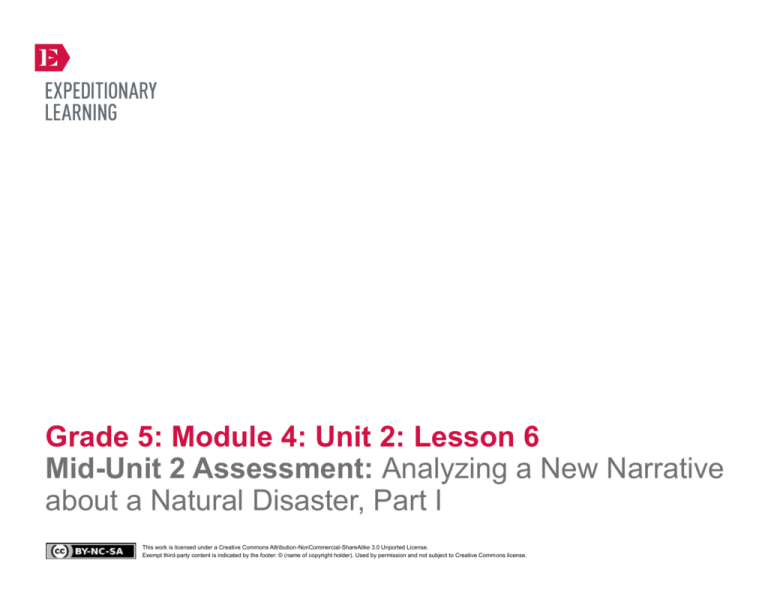
Grade 5: Module 4: Unit 2: Lesson 6
Mid-Unit 2 Assessment: Analyzing a New Narrative
about a Natural Disaster, Part I
This work is licensed under a Creative Commons Attribution-NonCommercial-ShareAlike 3.0 Unported License.
Exempt third-party content is indicated by the footer: © (name of copyright holder). Used by permission and not subject to Creative Commons license.
GRADE 5: MODULE 4: UNIT 2: LESSON 6
Mid-Unit 2 Assessment:
Analyzing a New Narrative about a Natural Disaster, Part I
Long-Term Targets Addressed (Based on NYSP12 ELA CCLS)
I can make inferences using quotes from the text. (RL.5.1)
I can analyze how visual and multimedia elements add to the meaning, tone, or beauty of literary text. (RL.5.7)
I can analyze figurative language, word relationships, and nuances in word meanings. (L.5.5)
Supporting Learning Targets
Ongoing Assessment
• I can infer about the narrator’s experience in “Save Bella!” as a survivor of a natural disaster, using
quotes from the text.
• Mid-Unit 2 Assessment: Analyzing a New Narrative
about a Natural Disaster, Part I
• I can analyze the meaning of figurative language in a new narrative about natural disasters.
• I can analyze how an image from the text adds meaning to the narrator’s description of events.
Agenda
Teaching Notes
1. Opening
• In this lesson, students take Part I of the Mid-Unit 2 Assessment. In this first part of the assessment,
students read the text and answer text-dependent questions to infer the meaning of the text, analyze
images, and determine the meaning of figurative language in a short story about Hurricane Sandy.
A. Learning Targets Review (5 minutes)
2. Work Time
A. Mid-Unit 2 Assessment (45 minutes)
3. Closing and Assessment
A. Tracking My Progress (5 minutes)
B. Sharing Reflections on Learning Targets (5 minutes)
4. Homework
A. No homework for this lesson.
Copyright © 2013 by Expeditionary Learning, New York, NY. All Rights Reserved.
• If students complete Part I of this assessment early, you may wish to have them continue on with Part II
(see Lesson 7) and take analysis notes to prepare for writing their literary analysis essays.
• In advance:
– The Unit 2 guiding question should remain posted, as it has all unit long, where students can see it
and refer to it: “What can literature about natural disasters teach us about their impact on the people
who experience them?”
– Make copies of Part II of the Mid-Unit 2 Assessment of Lesson 7 so that students who finish early can
begin to take notes for their literary analysis.
NYS Common Core ELA Curriculum • G5:M4:U2:L6 • January 2015 •
1
GRADE 5: MODULE 4: UNIT 2: LESSON 6
Mid-Unit 2 Assessment:
Analyzing a New Narrative about a Natural Disaster, Part I
Lesson Vocabulary
Materials
infer, quotes, analyze, image,
figurative language
• “In the Middle of the Storm” (assessment text; one per student)
• Mid-Unit 2 Assessment: Analyzing a New Narrative about a Natural Disaster, Part I (one per student)
• Tracking My Progress: Mid-Unit 2 Assessment, Part I recording form (one per student)
• Mid-Unit 2 Assessment: Analyzing a New Narrative about a Natural Disaster, Part I (answers, for teacher reference)
Meeting Students’ Needs
Opening
A. Learning Targets Review (5 minutes)
• Review each of the learning targets:
* “I can infer about the narrator’s experience in ‘Save Bella!’ as a survivor of a natural disaster, using quotes from the text.”
* “I can analyze how an image from the text adds meaning to the narrator’s description of events.”
* “I can analyze the meaning of figurative language in new narrative about natural disasters.”
• Point out the key words and phrases that students are familiar with from these learning targets. Ask students to turn to a
partner and explain what they will be doing for this first part of the assessment. Listen for: “We will be reading and analyzing
a new story about natural disasters,” “We will analyze images in a new text,” and “We will analyze the meaning of figurative
language in a new story.”
Copyright © 2013 by Expeditionary Learning, New York, NY. All Rights Reserved.
NYS Common Core ELA Curriculum • G5:M4:U2:L6 • January 2015 •
2
GRADE 5: MODULE 4: UNIT 2: LESSON 6
Mid-Unit 2 Assessment:
Analyzing a New Narrative about a Natural Disaster, Part I
Work Time
Meeting Students’ Needs
A. Mid-Unit 2 Assessment (45 minutes)
• Allow students who struggle with
language extra time to complete the
assessment.
• Distribute the text “In the Middle of the Storm” and the Mid-Unit 2 Assessment: Analyzing a New Narrative
about a Natural Disaster, Part I to each student.
• Read the directions aloud to students. Clarify as needed.
• Circulate to supervise; because this is a formal on-demand assessment, do not provide support other than formally approved
accommodations.
• If students finish the assessment early, you may choose to have them begin Part II of the mid-unit assessment (see Lesson
7).
Copyright © 2013 by Expeditionary Learning, New York, NY. All Rights Reserved.
NYS Common Core ELA Curriculum • G5:M4:U2:L6 • January 2015 •
3
GRADE 5: MODULE 4: UNIT 2: LESSON 6
Mid-Unit 2 Assessment:
Analyzing a New Narrative about a Natural Disaster, Part I
Meeting Students’ Needs
Closing and Assessment
A. Tracking My Progress (5 minutes)
• Distribute the Tracking My Progress: Mid-Unit 2 Assessment, Part I recording form to students.
• Remind students that they have used this self-assessment during previous modules to reflect upon their mastery of the
learning targets. Indicate that students probably have a good idea of where they stand after taking the mid-unit assessment,
and that this is a good time to honestly indicate if they feel they are on track or struggling and not understanding.
• Ask students to independently complete their Tracking My Progress forms. Ask them to hold on to this sheet to refer to
during the Debrief.
B. Sharing Reflections on Learning Targets (5 minutes)
• Congratulate students on how much they have learned so far about analyzing literature so they can better understand the
impact of extreme events on people’s lives and the surrounding environment. Tell them that tomorrow they will complete
Part II of their assessment by taking notes and writing a literary analysis of “In the Middle of the Storm.”
• Intentionally partner ELL students
with students who speak the same
home language in order to allow
them to focus on the debrief.
• Partner students. Ask them to share the reflections on their Tracking My Progress forms.
• Invite several students to share out with the whole group.
• Collect Part I of students’ mid-unit assessments and their Tracking My Progress forms, as well as their copy of “In the
Middle of the Storm.”
Homework
• No homework.
Note:
• Be sure you have given feedback to students’ literary analysis essays about “Save Bella!” (from Lesson 5) based on the literary analysis criteria. Students will reflect on
this feedback in advance of Part II of the mid-unit assessment.
• Some students may need more time to process feedback than is allotted in Lesson 7. For these students, consider sharing their feedback with them before Part II of the
mid-unit assessment and conferring with them about goals they would like to set for the assessment.
• In the upcoming end of unit assessment in Lesson 9, students will have the opportunity to create a piece of artwork to accompany a response to the guiding question.
It is an optional portion of that assessment. If you are interested in including the artwork option, review Lesson 9 now. To extend the arts integration of that lesson,
consider allowing students to use high-grade drawing paper and choose their art medium (colored pencils, pastels, watercolor). Another option is to collaborate with
your art resource teacher for a more thorough integration of the arts.
Copyright © 2013 by Expeditionary Learning, New York, NY. All Rights Reserved.
NYS Common Core ELA Curriculum • G5:M4:U2:L6 • January 2015 •
4
Grade 5: Module 4: Unit 2: Lesson 6
Supporting Materials
This work is licensed under a Creative Commons Attribution-NonCommercial-ShareAlike 3.0 Unported License.
Exempt third-party content is indicated by the footer: © (name of copyright holder). Used by permission and not subject to Creative Commons license.
GRADE 5: MODULE 4: UNIT 2: LESSON 6
Mid-Unit 2 Assessment:
Analyzing a New Narrative about a Natural Disaster, Part I
In the Middle of the Storm
By Reyna Eisenstark
1
2
3
4
We knew all about it before it happened. Everyone told us it was coming. The schools even closed
early. My mom says that when she was a kid growing up in New York City, school was never closed.
It was a big deal. It was October, 29, 2012, and it was my tenth birthday, but that wasn’t the big
deal. Hurricane Sandy was the big deal. It was going to hit the city. Of course I always knew that
New York was very close to the ocean, but a hurricane coming seemed weird. Hurricanes seemed
like foreign, tropical things, something that happens where it’s hot and humid, where there are
palm trees, places like Florida, not New York.
My grandma used to live in Florida and is obsessed with the ocean. She always says that when she
first came to New York, the thing she loved most was how you could take the subway to the ocean.
She loves taking my sister and me on the subway all the way out to Coney Island. We walk along
the beach, but we also go to the aquarium. I have to admit the ocean makes me a little nervous, but
I love the aquarium. I love how quiet and dark it is downstairs with the huge tanks of fish. It helps
ease my worries and makes me feel incredibly peaceful. I like to sit in front of the big tanks and
imagine I am a sea creature too, floating serenely along in the calm water, that is, when I’m not
chasing after my sister Janie. Once she ran off by herself in search of sharks. Luckily, we finally
found her at the octopus tank with her face stuck to the glass like a starfish. She’s sweet, but a little
unpredictable.
My mom and Janie and I live in Brooklyn, not as far out as Coney Island. We live in a brownstone.
It’s just what it sounds like, a building made out of brown stone. Our whole block is brownstones.
We live on the very top floor, which is the fourth floor. There are two bedrooms. Janie and I share
the bigger room, which isn’t really very big. My narrow bed is next to the window, though, and this
suits me just fine. At night, if I’m having trouble sleeping, I can peek under the curtain. I love to
look at the enormous old trees that line our entire block. These protectors stand with their huge
arms holding everyone on our block. I feel like keep us safe. My mom says that some of the biggest
trees have been here for over a hundred years. She says they have seen more than we will ever
know. Looking at those big old trees makes me feel peaceful too.
On the morning of October 29, 2012, I woke up excited. It was my tenth birthday! If it had been a
regular day, I would have gone to school and my mom would have brought in her famous cupcakes;
but school was closed and this made my birthday feel a little more special. Not only was I getting a
day off for my birthday, but a hurricane was coming too. I was excited, but also a little anxious. My
mom had prepared me a special fruit salad for breakfast, but I had too many butterflies in my
stomach to eat all that much. It’s when she flicked on the news that I started getting pretty nervous.
I began asking her lots of questions.
Copyright © 2013 by Expeditionary Learning, New York, NY. All Rights Reserved.
NYS Common Core ELA Curriculum • G5:M4:U2:L6 • January 2015 •
6
GRADE 5: MODULE 4: UNIT 2: LESSON 6
Mid-Unit 2 Assessment:
Analyzing a New Narrative about a Natural Disaster, Part I
5
6
7
8
“Will the storm be bad? Is it a hurricane like the kinds they get in Florida? Do we have to leave our
apartment? A lot of people are leaving!” My mom told us that we wouldn’t have to leave, but that we
would have to stay inside to be safe. “Safe from what? Are we in real danger?” I kept thinking. My
mom said it would be a severe storm. No one knew how strong it would be, but everyone was taking
precautions. People who lived closer to the water were being told to evacuate their homes, and those
who lived farther from the ocean, like us, were told to stay indoors. I was glad we could stay in our
apartment, but the excitement for my birthday was quickly beginning to evaporate.
I don’t remember exactly when it started, but at some point the rain and wind came. It was like a
regular thunderstorm at first. Nothing too bad, really. Janie asked my mom to tell us about that time
that she was waiting for a bus during high school when a really bad storm started. The wind was so
strong that she and her two friends were being blown around the street like loose newspaper. They
ran to an ice cream truck parked on the corner and begged the man inside to let them come in. They
waited out the storm in the back of the truck, sneaking sprinkles when the ice cream man wasn’t
looking. After the story, Janie looked out the window and I knew she wanted to go outside. She was
probably wondering what it would be like to blow around like loose paper in the wind. I was fine not
knowing.
Then we heard what sounded like an enormous crack. I had never heard anything so loud in my life.
It made us all jump and cry out. The crack made me think that the sky had actually torn in half! I
was pretty sure that wasn’t possible, but I couldn’t imagine what the sound was. And then, we heard
a huge crash outside. We rushed to the window in the living room that looked out onto our block. A
tree had been ripped out of the ground by its roots! Those enormous trees on our block were our
neighbors, our protectors, but now one of them had fallen right across the street and landed on a
parked blue car. The car alarm screeched and screeched. It sounded like the car was in agony, crying
out for help. The sounds from outside roared in our ears: the fierce wind, the crashing trees, the
screaming alarms. For a while, all we could do was stare outside in amazement. We didn’t know
whose car had been crushed, but it looked terrifying. Luckily, no one had been outside when the tree
crashed. And luckily, we didn’t even have a car!
My mom started taking pictures of our block from the
window. She showed us some pictures on her phone from
her friend Miguel. He was driving in Queens not far from
his house. He had driven right up to this bridge when he
had to turn around. You could see the water churning
under the bridge. No one had expected the water levels to
rise so high! The water was crashing into people’s houses!
Janie wanted to see more pictures, but I think my mom
saw the worried look on my face. She said, “No more
pictures right now, girls!” and put her phone away.
Copyright © 2013 by Expeditionary Learning, New York, NY. All Rights Reserved.
Photo used with permission by Miguel Chavez.
NYS Common Core ELA Curriculum • G5:M4:U2:L6 • January 2015 •
7
GRADE 5: MODULE 4: UNIT 2: LESSON 6
Mid-Unit 2 Assessment:
Analyzing a New Narrative about a Natural Disaster, Part I
9
10
11
12
13
All of a sudden, we felt a shaking right in our apartment. I screamed, “What’s happening?” We
could see that the windows in the living room were bending in from the force of the wind, almost
the way cards bend when you shuffle them. Except that windows are not supposed to bend.
“Mom!” I shouted. “Are the windows going to break?” “No, Rosa, of course not!” she shouted back.
But I could see she was just as scared as I was. Janie looked like she wanted to get a closer look.
My mom backed us out of the living room into the kitchen. And at that moment, all the lights went
out. Janie and I both cried out. “It’s okay, it’s okay,” said my mom, hugging us both. “We just lost
power! That’s all.” She ran over to what she calls the “utility drawer.” It is full of all sorts of things,
papers and menus and things like that. Luckily, it also had candles, which is what she was looking
for. She found the big box of matches we use for the stove sometimes and started to light the small
round candles. In the middle of lighting them, she said to me, “Well! It is your birthday, after all!
This is a good time to have candles, don’t you think?” I smiled at her, but I wasn’t feeling all that
happy about my birthday anymore. I kept thinking about the windows. What if they crashed in and
then all the wind and rain came into our apartment? I was so glad we lived on the top floor. But I
started worrying about our neighbors. What would happen if their apartments filled with water?
And my grandma, was she safe? Were her windows bending like cards?
My mom’s phone rang then, and it was Grandma. Mom and I had been worried about her, but
Grandma was totally fine. She lived in a very high apartment building in Manhattan. It was the
same building my mom had grown up in. So far, all that happened there was that her building had
been shaken a bit from the wind. She still had power, at least. My mom took the phone into her
bedroom to talk to Grandma. I followed her to the door and heard her say that she wasn’t sure if
she’d have cell service much longer.
When I turned back around, Janie was opening our front door just a crack. Was she crazy? What
was she doing? “Wow!” she said, her voice sounding thrilled and excited. “It’s so black in the
hallway!” But just then our small black cat, Maxine, shot out through the open door into the
hallway. “No!” I hissed, but it was too late. Maxine had never left our apartment before. I wonder if
the darkness and the howling wind had frightened her. Maybe she was trying to get away from it
all. But where would she go?
The hallway was so dark that I could only see Maxine’s eyes glowing for a single second. Then she
was gone. Janie immediately started running down the hallway following her. “What are you doing?
Come back here!” I whispered hoarsely, even though I felt like shouting. I didn’t want our mom to
hear me. “We have to go after Maxine!” called back Janie. I saw her dark shape bobbing down the
black hallway, and then she too was gone. “Janie!” I hissed. But she didn’t answer back.
Copyright © 2013 by Expeditionary Learning, New York, NY. All Rights Reserved.
NYS Common Core ELA Curriculum • G5:M4:U2:L6 • January 2015 •
8
GRADE 5: MODULE 4: UNIT 2: LESSON 6
Mid-Unit 2 Assessment:
Analyzing a New Narrative about a Natural Disaster, Part I
14
15
16
17
18
19
20
I didn’t know what to do. First Maxine, and now Janie was gone! I knew our mom was going to be
angry. At first, I thought I should just go back in and tell her what happened. But I didn’t want to get
Janie into trouble. She was always getting into trouble. Plus, what if she went outside? I had to
catch up with her and bring her back.
I started walking down the hallway, slowly. I thought that if I could just call Janie back, we could go
back inside and our mom could help us find Maxine. But I didn’t see Janie anywhere. When I finally
got to the end of the hallway, I noticed that someone had propped open the stairwell. And this
meant that Maxine must have run down the stairs. And Janie must have gone down after her. So
now I had to go after them both.
I held onto the wall as I made my way down to the next floor. It was so dark on the staircase that I
couldn’t even see my hand in front of my face. I could hear the roaring wind from outside. It kept
getting louder and louder as I slithered down the stairs along the wall. Once I called out, “Janie!”
But the fear in my own voice frightened me so much that I stopped immediately. And of course she
couldn’t hear me.
When I got to the bottom of the staircase, I stopped. The front door was wide open. The wind must
have blown it open. Janie was standing in the doorway, looking out. “Janie!” I shouted. She spun
around, looking shocked. Then without saying a word, she just pointed outside. We both stood there
in the doorway, looking out at the tree ripped up by its roots crushing the car, dark water swirling in
the street in front of us. Could Maxine be out there? It was too terrible to think about.
Suddenly we heard our mom’s frantic voice. “Girls? Girls!” she shouted. “Are you here?” “Mom!” we
shouted. She ran to us and pushed the door closed. “What are you doing?” she demanded. “You
cannot go out there! Come back upstairs with me!” By then, Janie and I were both crying. “But
Maxine! Maxine!” Janie kept saying. Our mom had come out of her bedroom and searched for us in
our dark apartment. She had run all the way down the stairs to find us.
Our mom took our hands in each of hers and helped us back up the stairs. She led us back into the
apartment. We went into my bedroom and the three of us sat on my bed, looking outside at the
crazy mess our street had become. The tree branches that had once looked like loving arms now
looked like arms flung every which way in confusion. I couldn’t believe I’d ever felt peaceful looking
out of that window.
“I’m sure Maxine didn’t go outside,” said Mom. “I’m sure she is hidden somewhere in this building.”
We were so worried about Maxine, but we knew there was nothing we could do at the time. Our gas
stove was working, and my mom decided to make her famous cupcakes by candlelight.
Copyright © 2013 by Expeditionary Learning, New York, NY. All Rights Reserved.
NYS Common Core ELA Curriculum • G5:M4:U2:L6 • January 2015 •
9
GRADE 5: MODULE 4: UNIT 2: LESSON 6
Mid-Unit 2 Assessment:
Analyzing a New Narrative about a Natural Disaster, Part I
21
22
22
23
24
25
My mom’s phone still had service at times, and we checked the news and looked at pictures. People
had it so much worse than we did. What was a little darkness? At least our apartment was high
above the storm. At least we hadn’t gotten trapped in our car somewhere near a bridge. At least the
ocean hadn’t risen up and burst through our front door.
Mom put birthday candles on the cupcakes when they came out of the oven, and I made a wish. I
probably shouldn’t say what the wish was, but of course I wished that Maxine was safe and that she
would come back to us.
When it was time for bed, I realized I couldn’t possibly sleep not knowing where Maxine was. Our
mom was in the bathroom with Janie, who was crying as she brushed her teeth. She felt the worst
because she was the one who had let Maxine out. No one blamed her, but she kept crying and crying.
Suddenly I felt braver. Maybe it was my birthday wish or something, but I decided then that I had to
find Maxine on my own. I knew Mom was keeping a strict eye on Janie. She had given her a stern
lecture about running after Maxine in the dark. But she would never expect me to leave the
apartment. I wouldn’t go outside, but I wanted to check the hallway once more.
I snuck over to our front door, opened it a crack, and peered down the hallway. It was just as dark as
ever. Maybe it was even darker than before. My heart started pounding as I slipped into the hallway.
I started running down the hall in the darkness. I wanted to get it over with as soon as possible.
Suddenly, I saw a pair of glowing eyes at the other end of the hall. Was I seeing things? “Maxine!” I
hissed. Suddenly I heard a meow in return! The glowing eyes ran toward me down the hallway. I
scooped her up and ran back to our apartment. “Mom!” I shouted. “Maxine is back!”
It took a while, but eventually our block got back to normal. Even so, I felt different somehow.
People came in to clear the dead branches strewn all over the street. The crushed blue car was towed
away. And our power came back on. My grandma was safe, and thankfully so was my sister. And
Maxine was back. No one could believe I had gone out to look for Maxine in the storm. I could tell
Janie was impressed. Even though my mom scolded me, I knew she was mostly relieved. And maybe
a little bit proud too.
So that was my tenth birthday. Each birthday since, I take a look out of my window at the enormous
old trees left on our block. I don’t really think of them as protectors anymore, but as friends. We
survived the storm together. We are a little bit older and a little bit stronger.
In the Middle of a Storm used with permission by Reyna Eisenstark.
Copyright © 2013 by Expeditionary Learning, New York, NY. All Rights Reserved.
NYS Common Core ELA Curriculum • G5:M4:U2:L6 • January 2015 •
10
GRADE 5: MODULE 4: UNIT 2: LESSON 6
Mid-Unit 2 Assessment:
Analyzing a New Narrative about a Natural Disaster, Part I
Mid-Unit 2 Assessment: Analyzing a New Narrative about a Natural Disaster, Part I
Name:
Date:
Directions:
• First, read “In the Middle of the Storm.”
• Then review the questions below.
• Reread the text to help you answer each question. Be sure to use evidence from the text when
answering written questions.
1. What is the gist of this story?
2. Reread Paragraph 4. In this paragraph, the narrator describes her feelings on the morning of her
birthday: “I was excited, but also a little anxious.”
a. Which word is a synonym (has a similar meaning) to “anxious”?
☐ disappointed
☐ nervous
☐ frustrated
b. What can you infer from this paragraph about why Rosa was anxious?
Copyright © 2013 by Expeditionary Learning, New York, NY. All Rights Reserved.
NYS Common Core ELA Curriculum • G5:M4:U2:L6 • January 2015 •
11
GRADE 5: MODULE 4: UNIT 2: LESSON 6
Mid-Unit 2 Assessment:
Analyzing a New Narrative about a Natural Disaster, Part I
3. What can you infer about Rosa as a person? How would you describe her? Use quotes from the
text to support your answer.
4. Look back at Paragraph 2. Reread the sentence “Luckily, we finally found her at the octopus tank
with her face stuck to the glass like a starfish.” Explain what the phrase “her face stuck to the glass
like a starfish” literally means.
5. Throughout the story, the trees are referred to as “protectors.” For example, in Paragraph 3 the
text says, “These protectors stand with their huge arms holding everyone on our block.” Which of the
following best explains the meaning of this sentence?
☐
☐
☐
☐
The narrator thinks the trees want to protect people on her block.
The narrator thinks the trees on her block have arms.
The narrator feels like the trees are protecting people on their block.
The narrator feels scared of the trees and wants to be protected from them.
Copyright © 2013 by Expeditionary Learning, New York, NY. All Rights Reserved.
NYS Common Core ELA Curriculum • G5:M4:U2:L6 • January 2015 •
12
GRADE 5: MODULE 4: UNIT 2: LESSON 6
Mid-Unit 2 Assessment:
Analyzing a New Narrative about a Natural Disaster, Part I
6. Reread Paragraph 4. What idiom does the narrator use to describe how she feels? What does this
idiom mean?
7. Look at the image next to Paragraph 8. Then reread this paragraph and answer this question: How
does this photo add meaning to the narrator’s description?
8. How does Hurricane Sandy affect Rosa and her family? Name three ways and provide a quote
from the text to support each.
1)
2)
3)
Copyright © 2013 by Expeditionary Learning, New York, NY. All Rights Reserved.
NYS Common Core ELA Curriculum • G5:M4:U2:L6 • January 2015 •
13
GRADE 5: MODULE 4: UNIT 2: LESSON 6
Mid-Unit 2 Assessment:
Analyzing a New Narrative about a Natural Disaster, Part I
Tracking My Progress: Mid-Unit 2 Assessment, Part I
Name:
Date:
Learning Target: I can infer about the narrator’s experience in “In the Middle of a Storm” as a
survivor of a natural disaster, using quotes from the text.
1. The target in my own words is:
2. How am I doing? Circle one.
I need more help
to learn this.
I understand
some of this.
I am on my way!
3. The evidence to support my self-assessment is:
Copyright © 2013 by Expeditionary Learning, New York, NY. All Rights Reserved.
NYS Common Core ELA Curriculum • G5:M4:U2:L6 • January 2015 •
14
GRADE 5: MODULE 4: UNIT 2: LESSON 6
Mid-Unit 2 Assessment:
Analyzing a New Narrative about a Natural Disaster, Part I
Tracking My Progress: Mid-Unit 2 Assessment, Part I
Learning Target: I can analyze the meaning of figurative language in a new narrative about natural
disasters.
1. The target in my own words is:
2. How am I doing? Circle one.
I need more help
to learn this.
I understand
some of this.
I am on my way!
3. The evidence to support my self-assessment is:
Copyright © 2013 by Expeditionary Learning, New York, NY. All Rights Reserved.
NYS Common Core ELA Curriculum • G5:M4:U2:L6 • January 2015 •
15
GRADE 5: MODULE 4: UNIT 2: LESSON 6
Mid-Unit 2 Assessment:
Analyzing a New Narrative about a Natural Disaster, Part I
Tracking My Progress: Mid-Unit 2 Assessment, Part I
Learning Target: I can analyze how an image from the text adds meaning to the narrator’s
description of events.
1. The target in my own words is:
2. How am I doing? Circle one.
I need more help
to learn this.
I understand
some of this.
I am on my way!
3. The evidence to support my self-assessment is:
Copyright © 2013 by Expeditionary Learning, New York, NY. All Rights Reserved.
NYS Common Core ELA Curriculum • G5:M4:U2:L6 • January 2015 •
16
GRADE 5: MODULE 4: UNIT 2: LESSON 6
Mid-Unit 2 Assessment:
Analyzing a New Narrative about a Natural Disaster, Part I
Mid-Unit 2 Assessment: Analyzing a New Narrative about a Natural Disaster, Part I
(Answers, for Teacher Reference)
Long-term Learning Targets Assessed:
Questions 2, 3, and 8: I can make inferences using quotes from the text. (RL.5.1)
Questions 4, 5, and 6: I can analyze figurative language, word relationships, and
nuances in word meanings. (L.5.5)
Question 7: I can analyze how visual and multimedia elements add to the meaning, tone,
or beauty of literary text. (RL.5.7)
1. What is the gist of this story?
This is a story about a girl named Rosa, who has her tenth birthday during Hurricane
Sandy.
2. Reread Paragraph 4. In this paragraph the narrator describes her feelings on the morning of her
birthday: “I was excited, but also a little anxious.”
a. Which word is a synonym (has a similar meaning) to “anxious”?
☐ disappointed
☐ nervous
☐ frustrated
b. What can you infer from this paragraph about why Rosa was anxious?
She was anxious because she was “getting a hurricane for her birthday.” This was
exciting, but also made her nervous.
Copyright © 2013 by Expeditionary Learning, New York, NY. All Rights Reserved.
NYS Common Core ELA Curriculum • G5:M4:U2:L6 • January 2015 •
17
GRADE 5: MODULE 4: UNIT 2: LESSON 6
Mid-Unit 2 Assessment:
Analyzing a New Narrative about a Natural Disaster, Part I
3. What can you infer about Rosa as a character? How would you describe her? Use quotes from the
text to support your answer.
Rosa is a girl who likes peace and quiet. For example, she describes loving “how quiet
and dark it is downstairs” at the aquarium. She is also a person who gets nervous,
though. On the morning of her birthday, she gets “anxious” thinking about the storm.
4. Look back at Paragraph 2. Reread the sentence “Luckily, we finally found her at octopus tank with
her face stuck to the glass like a starfish.” Explain what “her face stuck to the glass like a starfish”
literally means.
Her face was pressed against the glass, similar to the way a starfish sticks to something.
5. Throughout the story the trees are referred to as “protectors.” For example, in Paragraph 3 the text
says, “These protectors stand with their huge arms holding everyone on our block.” Which of the
following best explains the meaning of this sentence?
☐
☐
☐
☐
The narrator thinks the trees want to protect people on her block.
The narrator thinks the trees on her block have arms.
The narrator feels like the trees are protecting people on their block.
The narrator feels scared of the trees and wants to be protected from them
6. Reread Paragraph 4. What idiom does the narrator use to describe how she feels? What does this
idiom mean?
“I had too many butterflies in my stomach.”
This means she felt nervous and her stomach was upset.
Copyright © 2013 by Expeditionary Learning, New York, NY. All Rights Reserved.
NYS Common Core ELA Curriculum • G5:M4:U2:L6 • January 2015 •
18
GRADE 5: MODULE 4: UNIT 2: LESSON 6
Mid-Unit 2 Assessment:
Analyzing a New Narrative about a Natural Disaster, Part I
7. Look at the image next to Paragraph 8. Then reread this paragraph and answer this question: How
does this photo add meaning to the narrator’s description?
It looks like the picture that Rosa’s mom got from her friend Miguel. Rosa describes
the pictures and the water: “You could see the water churning under the bridge.”
I think the picture helps the reader understand how bad the flooding was.
8. How does Hurricane Sandy affect Rosa and her family? Name three ways and provide a quote
from the text to support each.
Some possible answers:
Rosa had to stay home from school on her birthday. “School was closed and
this made my birthday feel a little more special.”
A tree fell on their street. “A tree had been ripped out of the ground by its
roots!”
They were frightened by the wind. I screamed, “What’s happening?”
They lost power in their apartment. “We just lost power!”
They were worried about their family, friends, and neighbors, “I started
worrying about our neighbors…. And my grandma, was she safe?”
Their cat ran into the hallway and almost got lost. “Maxine shot out through
the open door into the hallway.”
Copyright © 2013 by Expeditionary Learning, New York, NY. All Rights Reserved.
NYS Common Core ELA Curriculum • G5:M4:U2:L6 • January 2015 •
19
GRADE 5: MODULE 4: UNIT 2: LESSON 6
Mid-Unit 2 Assessment:
Analyzing a New Narrative about a Natural Disaster, Part I
2-Point Rubric: Writing from Sources/Short Response1
(for Teacher Reference)
Use the below rubric for determining scores on short answers in this assessment.
2-point Response
The features of a 2-point response are:
Valid inferences and/or claims from the text where required by the prompt
Evidence of analysis of the text where required by the prompt
Relevant facts, definitions, concrete details, and/or other information from the
text to develop response according to the requirements of the prompt
Sufficient number of facts, definitions, concrete details, and/or other
information from the text as required by the prompt
Complete sentences where errors do not impact readability
1-point Response
The features of a 1-point response are:
A mostly literal recounting of events or details from the text as required by the
prompt
Some relevant facts, definitions, concrete details, and/or other information
from the text to develop response according to the requirements of the
prompt
Incomplete sentences or bullets
0-point Response
The features of a 0-point response are:
A response that does not address any of the requirements of the prompt or is
totally inaccurate
No response (blank answer)
A response that is not written in English
A response that is unintelligible or indecipherable
1From
New York State Department of Education, January 2016.
Copyright © 2013 by Expeditionary Learning, New York, NY. All Rights Reserved.
NYS Common Core ELA Curriculum • G5:M4:U2:L6 • January 2015 •
20


